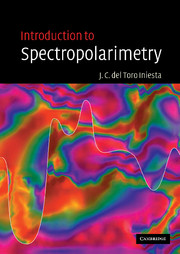Book contents
- Frontmatter
- Contents
- Preface
- Acknowledgements
- 1 Historical introduction
- 2 A review of some basic concepts
- 3 The polarization properties of quasi-monochromatic light
- 4 Linear optical systems acting on polarized light
- 5 Solar polarimetry
- 6 Absorption and dispersion
- 7 The radiative transfer equation
- 8 The RTE in the presence of a magnetic field
- 9 Solving the radiative transfer equation
- 10 Stokes spectrum diagnostics
- 11 Inversion of the RTE
- Index
10 - Stokes spectrum diagnostics
Published online by Cambridge University Press: 11 August 2009
- Frontmatter
- Contents
- Preface
- Acknowledgements
- 1 Historical introduction
- 2 A review of some basic concepts
- 3 The polarization properties of quasi-monochromatic light
- 4 Linear optical systems acting on polarized light
- 5 Solar polarimetry
- 6 Absorption and dispersion
- 7 The radiative transfer equation
- 8 The RTE in the presence of a magnetic field
- 9 Solving the radiative transfer equation
- 10 Stokes spectrum diagnostics
- 11 Inversion of the RTE
- Index
Summary
Dixo mio Ç id: “yo desto so pagado;
“quando agora son buenos, adelant serán preÇiados.”
—Anonymous, approx. 1140.‘With that I am well paid,’ said the Cid;
‘Those that are now worthy, shall henceforth be rewarded.’
The main problem in astrophysics is that of inferring the physical properties of the medium from the observables: the Stokes spectrum. Unfortunately, no in situ measurements can be made of the temperatures, densities, velocities, magnetic fields, and other physical quantities to probe the astronomical object, or at least that portion of the astronomical object where photons come from. Astrophysical measurements are of the physical properties of the (polarized) radiation, not of the celestial object itself. From these measurements, and with the help of some known physics, the astronomer is challenged to infer the properties of the medium that light has passed through. Certainly, we speak loosely when we use the same word measurement for both the process of characterizing light and that of interpreting the observed Stokes spectrum in terms of the medium properties: calibration is neither as easy nor as accurate as in laboratory measurements. The only available “meter” is the RTE, which contains the relationship between the observable (the Stokes spectrum) and the unknowns (the medium physical quantities). More specifically, the link between the medium and the observable lies in the coefficients of the RTE, namely, the propagation matrix and the source function vector.
- Type
- Chapter
- Information
- Introduction to Spectropolarimetry , pp. 165 - 198Publisher: Cambridge University PressPrint publication year: 2003



